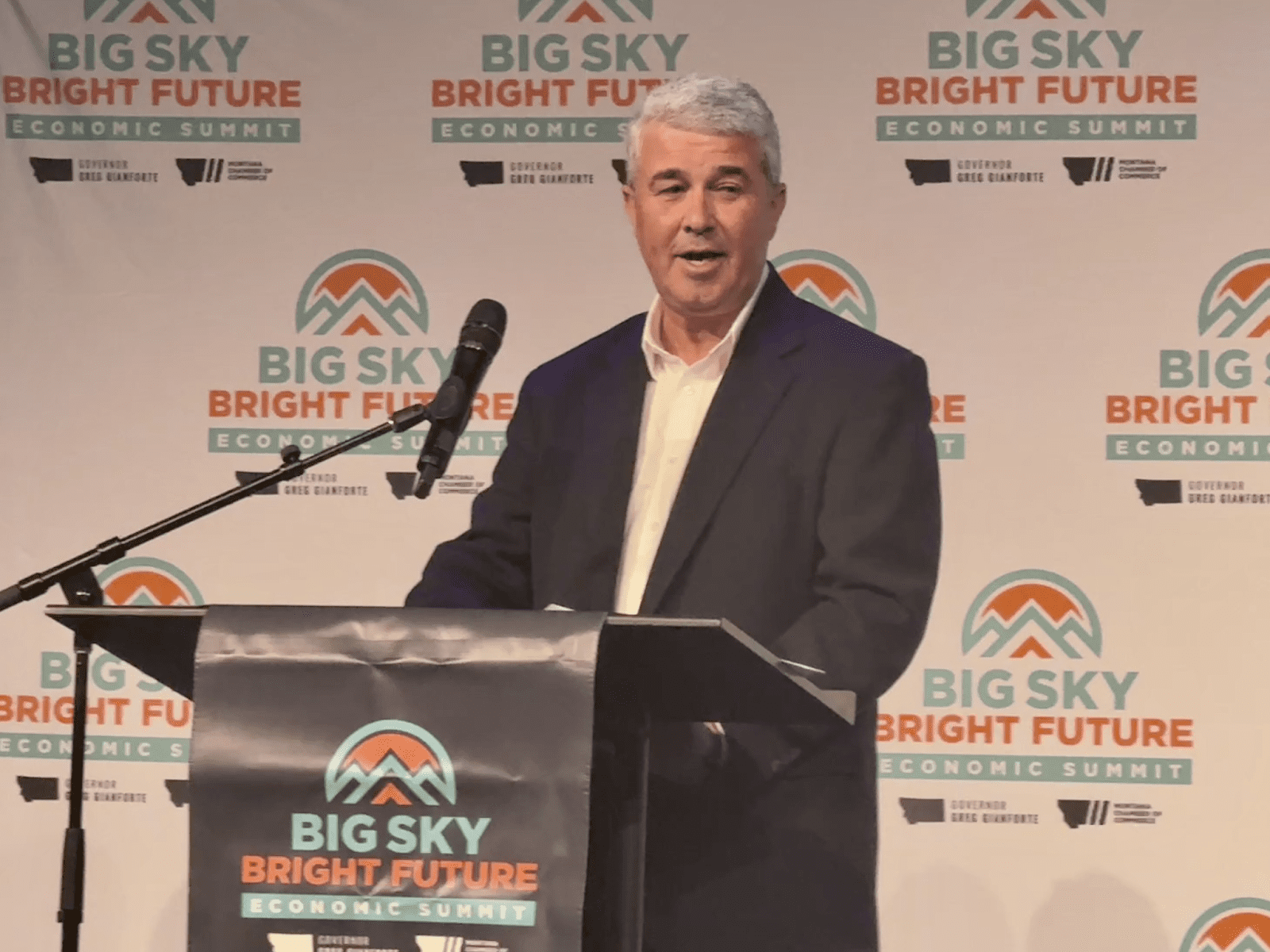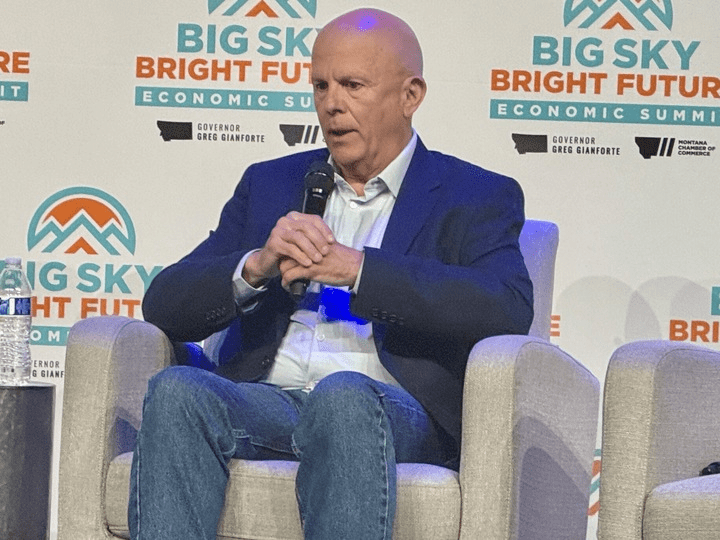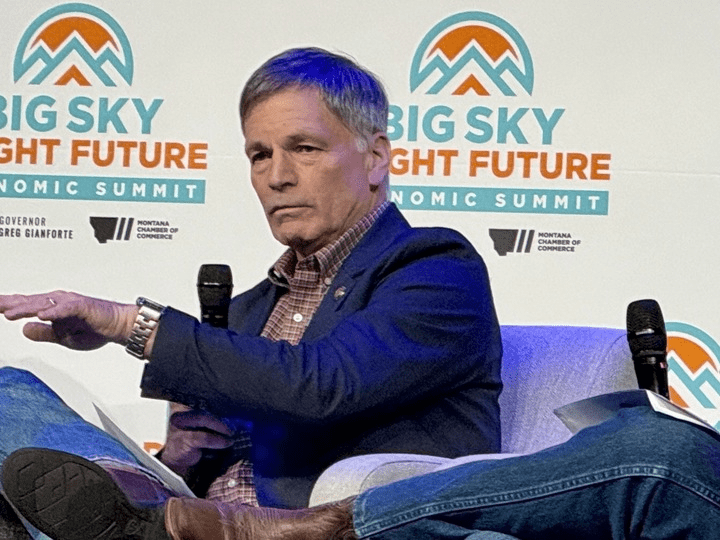Four perspectives on trends to watch in energy production, transmission expansion and the increasing adoption of AI
By Amanda Eggert MONTANA FREE PRESS
At a daylong summit last week co-hosted by Montana's Republican Gov. Greg Gianforte and the Montana Chamber of Commerce, politicians and energy industry insiders outlined a vision for the fossil fuel-heavy country with few regulatory hurdles and short permitting timelines.
Over 300 people from across the state and country gathered on October 16 for the event, which was intended to be a forum for energy producers and consumers to discuss growth and innovation in the energy sector. The event's top sponsors included Google, Stockman Bank and Americans for Prosperity, a free-market think tank founded by oil and gas billionaires Charles and David Koch.
Below are four speakers' views on trends to watch as companies and government regulators face increasing investments in energy-intensive data centers that run headlong into power generation and transmission bottlenecks.
NextEra Executive: Montana's largest wind farm to get solar and battery upgrade

Florida-based energy giant NextEra is integrating battery storage into “pretty much every new energy project” it is currently building, according to Jim Shandalov, the company's national vice president of power generation.
He told conference attendees that declining prices for utility-scale batteries, coupled with innovations in efficiency and energy density, are making batteries more economical for both the utilities to which NextEra sells power and for the Florida company.
Shandalov said NextEra is “actively working” to add solar and wind storage to the Clearwater Wind Project, which converts eastern Montana wind in Rosebud, Custer and Garfield counties into 776 megawatts of electricity for utilities in the Pacific Northwest.
“All this energy is flowing [to Washington and Oregon]”, he said. “However, the economic benefits of this project remain, [including] $200 million in land payments to landowners over the life of the project.”
NextEra has another wind farm in the works in eastern Montana, Shandalov added. An 800-megawatt project called Glendive Wind, which is in the planning stages, could generate enough electricity to power 300,000 homes, he said. Between the Glendive project, the Clearwater project and its expansion, NextEra's investments in energy projects in eastern Montana are expected to exceed $3.5 billion in the coming years.
Yzaguirre, LLC: The AI and data center market is “durable,” but power is the bottleneck

Max Yzaguirre, a lawyer who has held various positions in energy, telecommunications, real estate and investments, said there is “permanent” investment in AI, but there is a mismatch between market growth and energy development timelines.
“I personally think we are in a global arms race,” Yzaguirre said of adopting AI, adding that it comes with trade-offs.
“I think the demand is permanent and we need to find a way to meet it. These companies essentially need two things: They need chips and they need power. Without both, they're out of business. Right now, power is the bottleneck and we need to find a way to move faster.”
NorthWestern Energy, Montana's largest utility, has tentative contracts with at least two data centers. A project proposed by TAC Data Centers includes 600 megawatts for a project outside of Great Falls. Another agreement announced with a recently formed company called Quantica Infrastructure calls for up to 1,000 megawatts of electricity to power a center to be built in Yellowstone County. To meet this demand, Quantica would have to use virtually every megawatt of electricity that the power plants NorthWestern currently owns can produce.
Quantica CEO John Chesser also attended the conference. At a panel discussion hosted by Sonja Nowakowski, director of the Montana Department of Environmental Quality, Chesser called on the state to create an actionable policy “roadmap” so potential customers and investors feel confident working with companies like Quantica. He said key components of this roadmap should include industry-friendly changes to electricity, transmission and telecommunications infrastructure.
CEO of Grid United: Expanding transmission capacity can alleviate electricity capacity bottlenecks

Michael Skelly, co-founder and CEO of transmission developer Grid United, said building transmission lines can help new power plants reach markets while giving existing generators the opportunity to serve regions with smooth peaks in electricity consumption.
“Capacity is the big issue in our industry right now: Where do we get electrons that we can always rely on? One way to achieve that is of course to build new facilities. Another way is to share resources,” he said. “In many, many cases, finding ways to share resources is much more cost effective than building new ones, not to mention in terms of timescales [to permit and build new plants].”
Skelly's company is developing the North Plains Connector, a 525-kilovolt line planned for eastern Montana and western North Dakota that, if built, would carry 3,000 megawatts of electricity between the eastern and western grids.
Skelly said Grid United uses a “very intense stakeholder focus” when building projects like the North Plains Connector.
While Grid United has secured land access agreements for about 95% of the planned 400-mile transmission line route, the company is still waiting for a $700 million federal grant.
In August 2024, the U.S. Department of Energy announced that it would award the grant to Montana to facilitate construction of the North Plains Connector, a $4.6 billion project. However, that payout appears to have stalled as President Donald Trump has rolled back climate change-related grants and loans.
In June, U.S. Senator Steve Daines called on Energy Secretary Chris Wright to keep the subsidy flowing through the DC funding pipeline. Wright told Daines that the project was “very logical” and “very encouraging,” but then admitted that his agency was still reviewing it.
Energy industry insiders suggested that Wright might announce the release of the $700 million in funding at the summit, but no such announcement was made. Due to the federal government shutdown, Wright, who was scheduled to speak in person, spoke to attendees remotely.
In other grid-related news, Berkshire Hathaway Energy announced at the conference that its foundation is donating $1.4 million to fund the establishment of a grid operator training program at Montana State University's Great Falls College campus. Construction of the training center is scheduled to begin in 2026, with the first year of students starting their studies in the fall.
Wyoming Governor: There's a 'bright' future for coal in the West, but mining companies need to make viable leasing offers

Wyoming Gov. Mark Gordon said he welcomed expanded access to federal coal leases under the Trump administration, but argued that access is only part of the equation.
“We need to offer coal leases. And coal companies need to offer more for those leases than a new dump truck costs,” he said. “The future is really bright and we need to make sure we have it.”
Despite efforts to expand access to federal coal, ranging from reduced royalties to reopening the Powder River Basin for new coal mines, the Bureau of Land Management does not see coal demand increasing.
Only a single company offered federal coal in southeastern Montana earlier this month, and its offer was so low that the BLM rejected it. The Navajo Transitional Energy Co., a company owned by the Navajo tribe, offered $186,000 to lease 167 million tons of coal, equivalent to one-tenth of a penny per ton of coal.
According to an Associated Press report, NTEC suggested in advance of the lease sale that coal had little value due to declining demand.
WyoFile reported earlier this month that a coal lease sale scheduled for Oct. 8 in Wyoming was postponed indefinitely, apparently in response to the lackluster lease sale in Montana.
Still, several speakers at the summit, including NorthWestern Energy, remain optimistic about coal's prospects, arguing that electricity demand forecasts and the need for on-demand baseload power will keep coal viable.
John Hines, vice president of utilities and Montana government affairs for NorthWestern Energy, said his company has 370 megawatts of capacity, made possible by the planned Jan. 1 transfer of ownership of the Colstrip power plant.
“But given the size of some of these large loads we're talking about, that's going to be used up pretty quickly. We need to be able to move forward quickly with developing that infrastructure.” [to meet] their needs,” he said.
The Montana Public Service Commission is also looking into the data center issue. In March, the agency raised concerns about grid reliability and the impact on NorthWestern's customers who can't buy electricity elsewhere.
